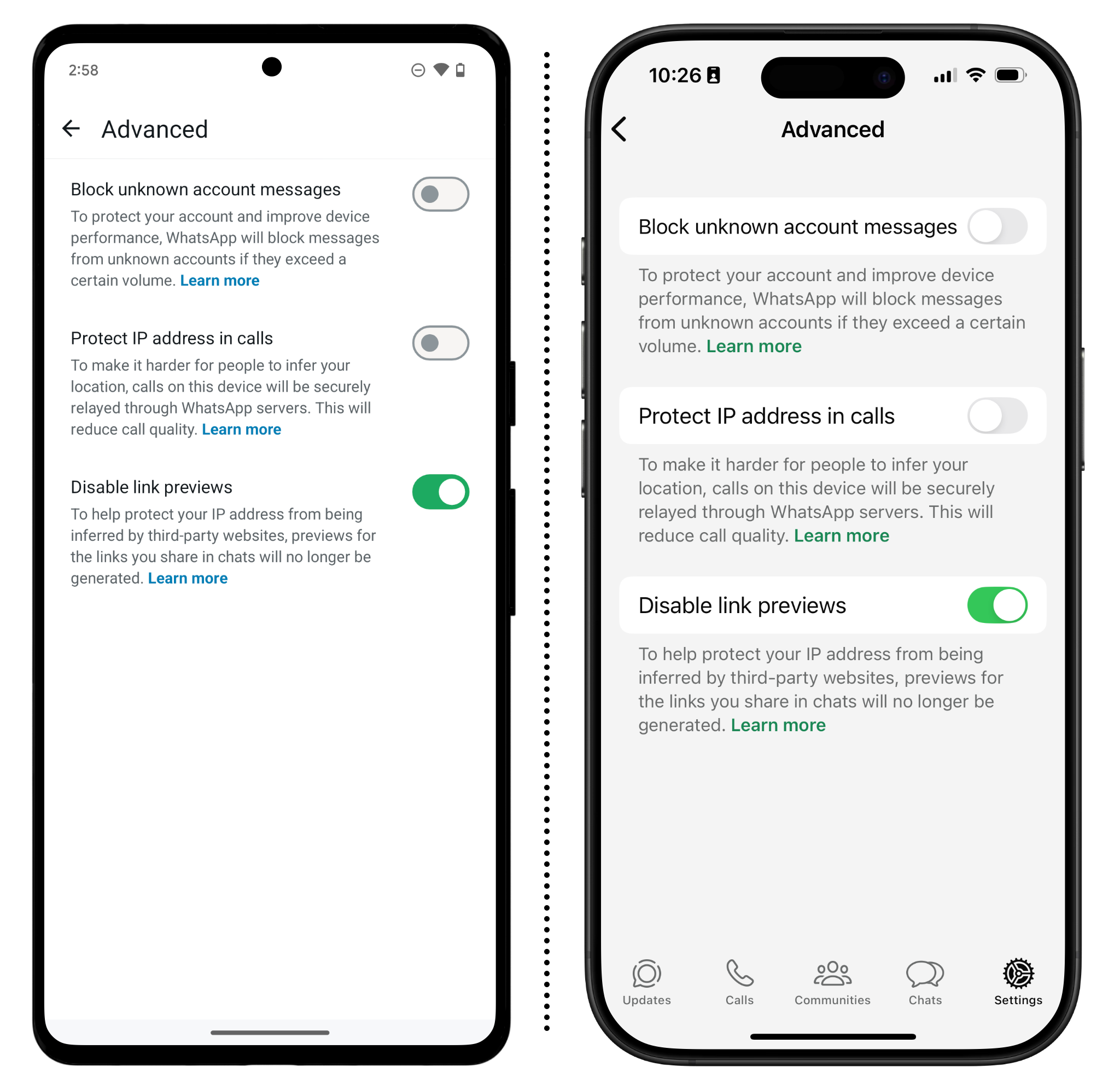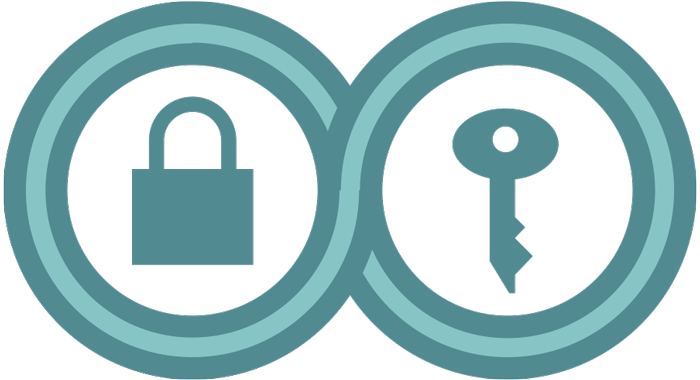Cómo: Usar WhatsApp
Última actualización: April 03, 2025
Algunas de las funciones de seguridad más útiles de WhatsApp no están activadas por defecto. Tendrás que entrar activamente y configurarlas tú mismo (¡y pedir a tus contactos que hagan lo mismo!).
Ubicación de la descarga: Google Play Store o Apple App Store
Requisitos del sistema: Android 5 o posterior, iOS 12 o posterior
Versión utilizada en esta guía: 2.23.13.76
Licencia: Propietaria
Otras lecturas:
- https://blog.whatsapp.com/10000618/end-to-end-encryption
- https://www.whatsapp.com/security/WhatsApp-Security-Whitepaper.pdf
- https://medium.com/@thegrugq/operational-whatsapp-on-ios-ce9a4231a034/
Nivel: Principiante
Tiempo necesario 15-20 minutos
WhatsApp es una aplicación que te permite comunicarte de forma segura uno a uno, enviar archivos y participar en chats de grupo. Aunque WhatsApp utiliza números de teléfono como contactos, las llamadas y los mensajes utilizan tu conexión de datos; por tanto, ambas partes de la conversación deben tener acceso a Internet en sus dispositivos móviles. Debido a esto, los usuarios de WhatsApp no incurren en gastos de SMS y MMS.
WhatsApp es propiedad y está gestionada por Meta. La aplicación en sí es un software de código cerrado, lo que significa que es difícil para los expertos externos confirmar que la empresa ha implementado su cifrado de forma segura. Pero WhatsApp sí utiliza el cifrado de extremo a extremo, que garantiza que un mensaje es convertido en un mensaje secreto por su remitente original, y descifrado sólo por su destinatario final. Esperamos que el protocolo de cifrado que utiliza WhatsApp, el Protocolo Signal, se generalice en el futuro.
Aunque el protocolo de cifrado es sólido, las prácticas de privacidad de WhatsApp y su empresa matriz son preocupantes. Desde 2016, WhatsApp comparte datos con Facebook (ahora Meta), y aunque eso no incluye el contenido de los mensajes, sí incluye otra información, como tu número de teléfono, registros de la frecuencia con que utilizas WhatsApp, direcciones IP, identificadores de dispositivos y otros metadatos similares. Aunque esto evita utilizar el contenido de tus mensajes para dirigir anuncios, sigue siendo una cantidad incómoda de datos compartidos que no encontrarás en el mayor competidor de WhatsApp, Signal .
También hay motivos de preocupación con la aplicación web de WhatsApp. WhatsApp proporciona una interfaz web segura HTTPS para enviar y recibir mensajes. Como ocurre con todos los sitios web, los recursos necesarios para cargar la aplicación se entregan cada vez que visitas ese sitio. Debido a esto, es técnicamente posible que la aplicación web pueda ser modificada para servir una versión maliciosa, que entonces sería capaz de entregar todos tus mensajes a un tercero. Si quieres utilizar WhatsApp en tu ordenador, considera las aplicaciones de escritorio en su lugar para Windows y Mac.
Cómo utilizar esta guía: Esta guía comienza con los aspectos básicos para configurar y utilizar WhatsApp por primera vez. Si ya tienes experiencia con la aplicación y buscas formas de mejorar tu privacidad mientras la utilizas, salta a la sección Ajustes de seguridad adicionales.
Descargar e instalar WhatsApp
Lo primero es lo primero: tendrás que descargar la aplicación WhatsApp en tu teléfono. Puedes buscar "WhatsApp" en Google Play o Apple App Store o descargarla directamente desde los enlaces que aparecen a continuación:
- En Android: Descarga la aplicación desde Google Play Store aquí.
- En iPhone: Descarga la aplicación desde Apple App Store aquí.
Cuando WhatsApp termine de descargarse, inicia la aplicación. Los ajustes y las pantallas pueden tener un aspecto diferente, dependiendo de tu versión de Android y del fabricante de tu teléfono.
Registrar y verificar tu número de teléfono
Antes de poder utilizar WhatsApp, tendrás que aceptar las Condiciones del servicio y la Política de privacidad. Pulsa "Aceptar y continuar".
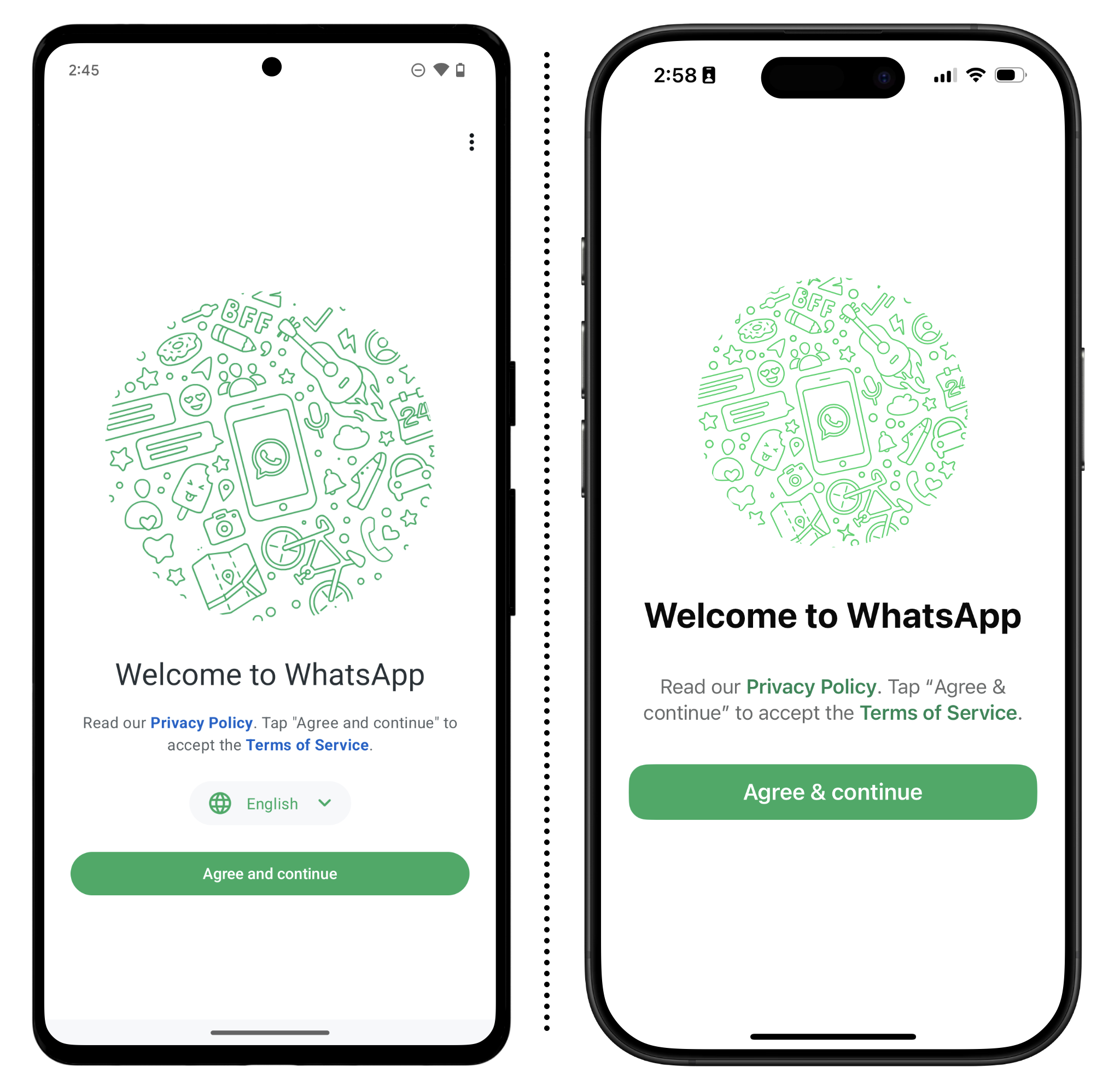
Cuando se te solicite, introduce tu número de teléfono móvil y, a continuación, pulsa "Siguiente". " . Aunque WhatsApp no utiliza SMS, tu número de teléfono seguirá siendo visible para todos tus contactos. Si no quieres utilizar tu número de teléfono principal, la Fundación para la Libertad de Prensa tiene consejos para conseguir un número secundario , pero debes saber que WhatsApp no admite números VoIP , como los que obtienes de un servicio como Google Voice, por lo que tendrás que conseguir una tarjeta SIM y un número de teléfono aparte.
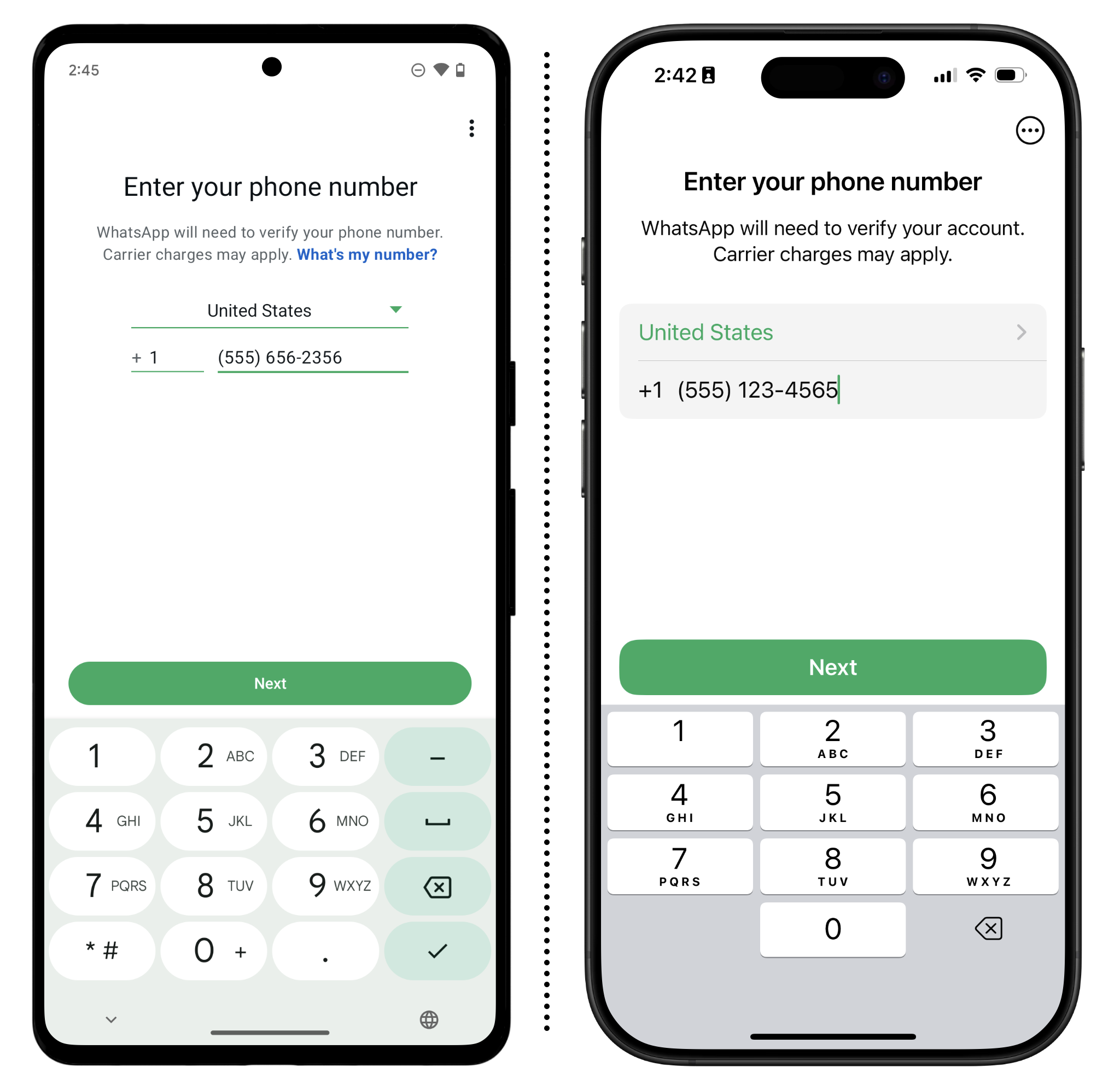
Para confirmar tu número de teléfono, se te enviará un SMS con un código de seis dígitos. Introduce ese código cuando se te solicite. A continuación, se te pedirá que introduzcas tu nombre y añadas una foto de perfil. Ten en cuenta que lo que utilices para tu perfil será visible para todos tus contactos.

WhatsApp solicitará acceso a tus contactos. Si concedes este acceso, WhatsApp tendrá una lista completa de tus números de teléfono. En Android, debes conceder acceso a tus contactos para poder enviar mensajes o iniciar llamadas telefónicas. En iPhone, puedes rechazar el acceso a tus contactos y la aplicación seguirá funcionando o sólo puedes aprobar el acceso a contactos específicos . Opcionalmente, puedes restringir los nuevos contactos que añadas a WhatsApp para que no aparezcan en la aplicación de contactos de tu teléfono.
- En Android: Pulsa "Continuar" y luego "Permitir" para conceder acceso a tus contactos.
- En iPhone: Pulsa "Continuar" y, a continuación, elige entre seleccionar contactos específicos a los que WhatsApp pueda acceder o conceder acceso a todos tus contactos.
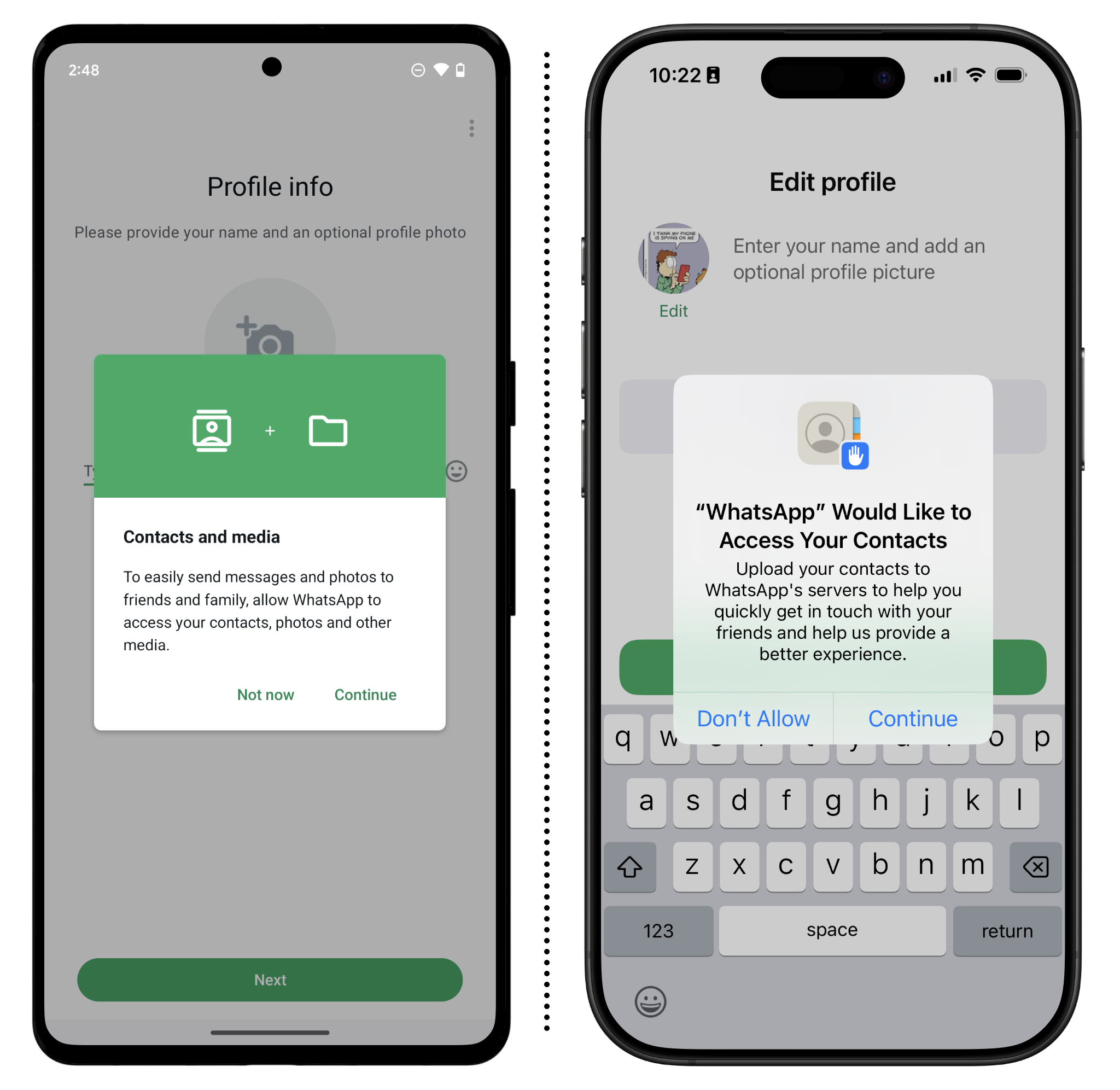
Si quieres enviar fotos, contenido multimedia o archivos, WhatsApp también te pedirá acceso a ellos.
Utilizar WhatsApp
Para utilizar WhatsApp, la persona a la que envíes mensajes o llames también debe tener WhatsApp instalado. Puedes iniciar un chat o una llamada desde la aplicación escribiendo un número de teléfono manualmente, o escribiendo el nombre de un contacto si le has dado acceso a tu lista de contactos. Puedes iniciar chats de grupo del mismo modo, añadiendo tantas personas como quieras a un hilo de texto.
- En Android: Selecciona la pestaña "Chats" (o "Llamadas") y luego toca el icono de mensaje en la parte inferior derecha. Selecciona el contacto con el que deseas iniciar una conversación.
- En iPhone: Toca la opción "Chats" (o "Llamadas") en la barra de navegación inferior y, a continuación, toca el icono de mensaje en la parte superior derecha. Selecciona el contacto con el que deseas iniciar una conversación.
Cuando se inicie tu primera conversación encriptada, verás un mensaje que describe cómo funcionan los mensajes que desaparecen. Haz clic en "Aceptar" y pasarás a la pantalla de nuevo mensaje. Verás una nota en la parte superior de cada hilo de mensajes que dice: "Los mensajes y las llamadas están encriptados de extremo a extremo. Nadie ajeno a este chat, ni siquiera WhatsApp, puede leerlos o escucharlos. Toca para obtener más información", seguido de más información sobre la configuración predeterminada para la desaparición de mensajes (más información sobre la desaparición de mensajes más adelante).
En este punto, puedes verificar la autenticidad de la persona con la que estás hablando, para asegurarte de que su clave de cifrado no ha sido manipulada o sustituida por la clave de otra persona cuando tu aplicación la descargó (un proceso llamado verificación de llave ). Se trata de un paso opcional que puede no ser necesario para todas las personas con las que te comuniques, pero que puede ser útil en los casos en que estés hablando de información privada. El proceso funciona igual tanto en Android como en iPhone:
Para verificar, pulsa en su nombre (o número de teléfono) en la parte superior y, en la siguiente pantalla, pulsa "Cifrado".
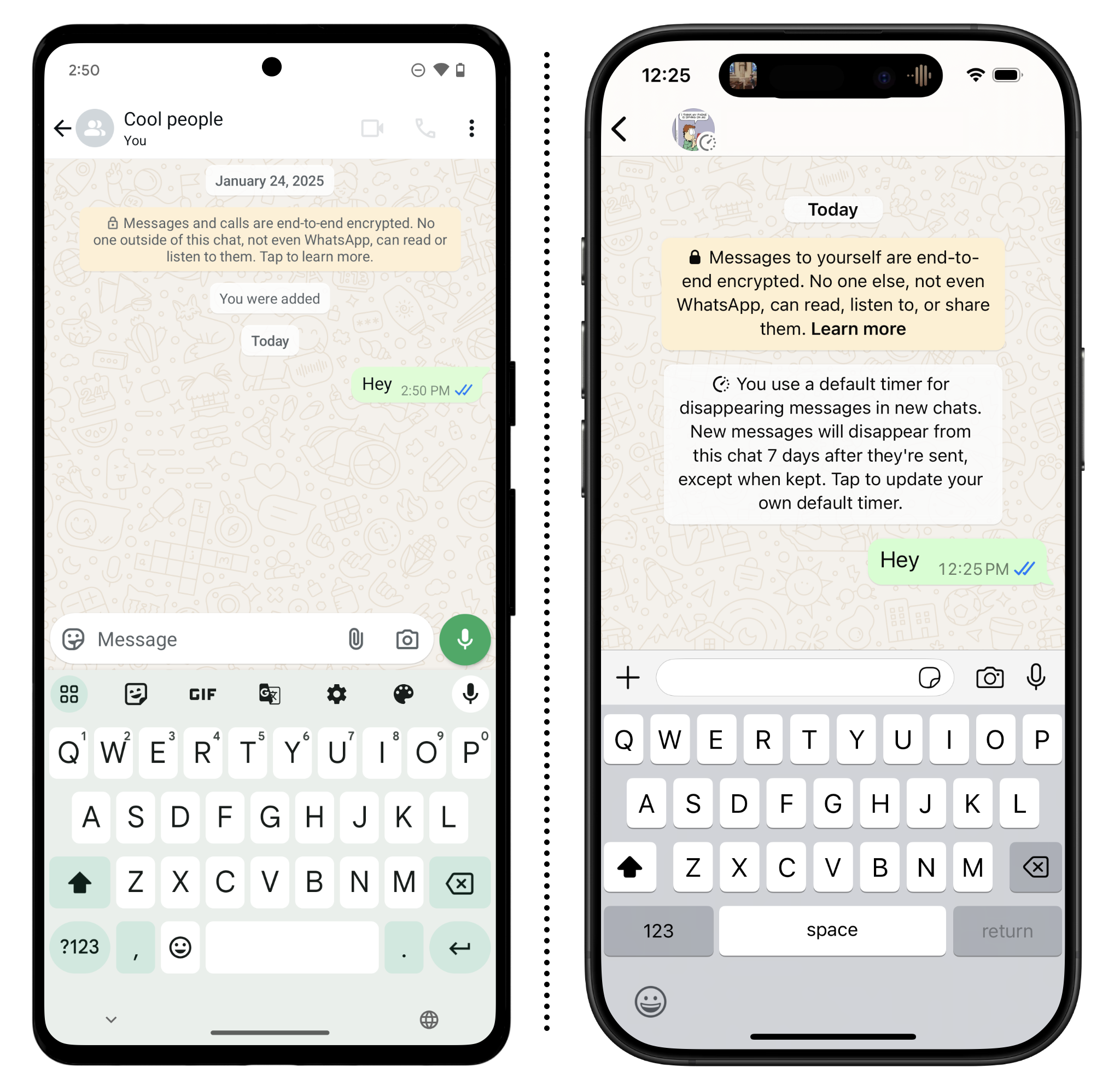
Haz que tu contacto siga el mismo proceso en su teléfono. La siguiente pantalla se titulará "Verificar código de seguridad".
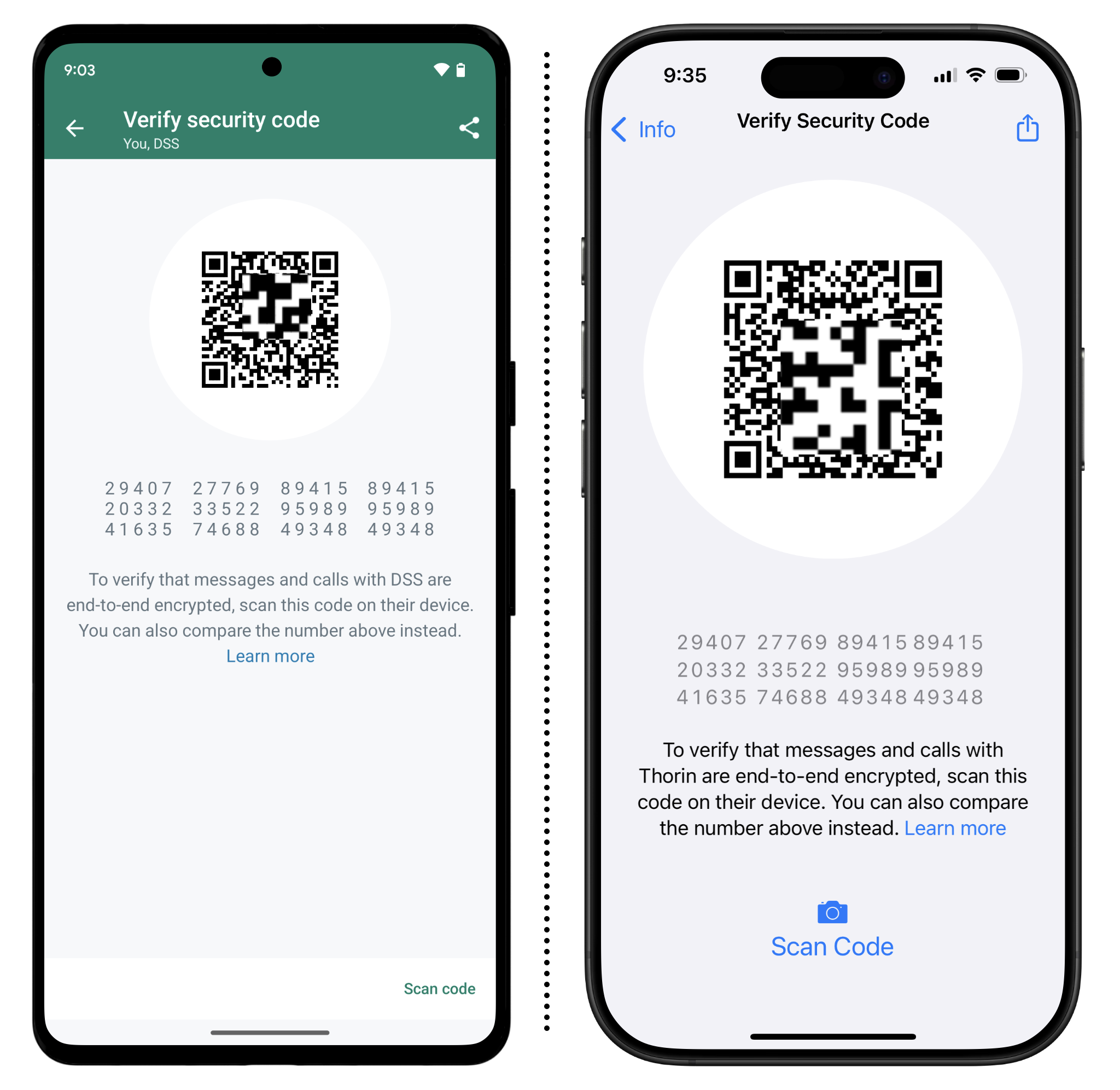
Verás una cadena de 60 números. Puedes verificarlo leyendo manualmente estos números y asegurándote de que se corresponden con los de tu contacto, o si estáis en el mismo lugar, también puedes escanear su código QR que aparece en esta pantalla. Si es necesario, también puedes hacer una captura de pantalla de los números y compartirla a través de un canal seguro secundario.
Una vez hecho esto, puedes estar seguro de que las comunicaciones cifradas con este contacto realmente sólo son accesibles por ti mismo y por tu contacto. Esto se aplica tanto a los mensajes de texto dentro de WhatsApp como a las llamadas de voz de WhatsApp.
Gestiona tus chats de grupo y preferencias de comunidades
Además de los chats uno a uno, WhatsApp también admite chats de grupo y chats de comunidad (que son básicamente grupos más grandes de chats de grupo). Al igual que con los chats, tanto los chats de grupo como los chats de comunidad están cifrados de extremo a extremo.
Para crear un nuevo chat de grupo
- En Android Selecciona la pestaña "Chats" y, a continuación, toca el icono de mensaje de la parte inferior derecha. Selecciona "Nuevo grupo" y, a continuación, los contactos con los que deseas iniciar una conversación.
- En iPhone: Toca la opción "Chats" (o "Llamadas") en la barra de navegación inferior y, a continuación, toca el icono de mensaje en la parte superior derecha. Selecciona "Nuevo grupo" y, a continuación, los contactos con los que deseas iniciar una conversación.
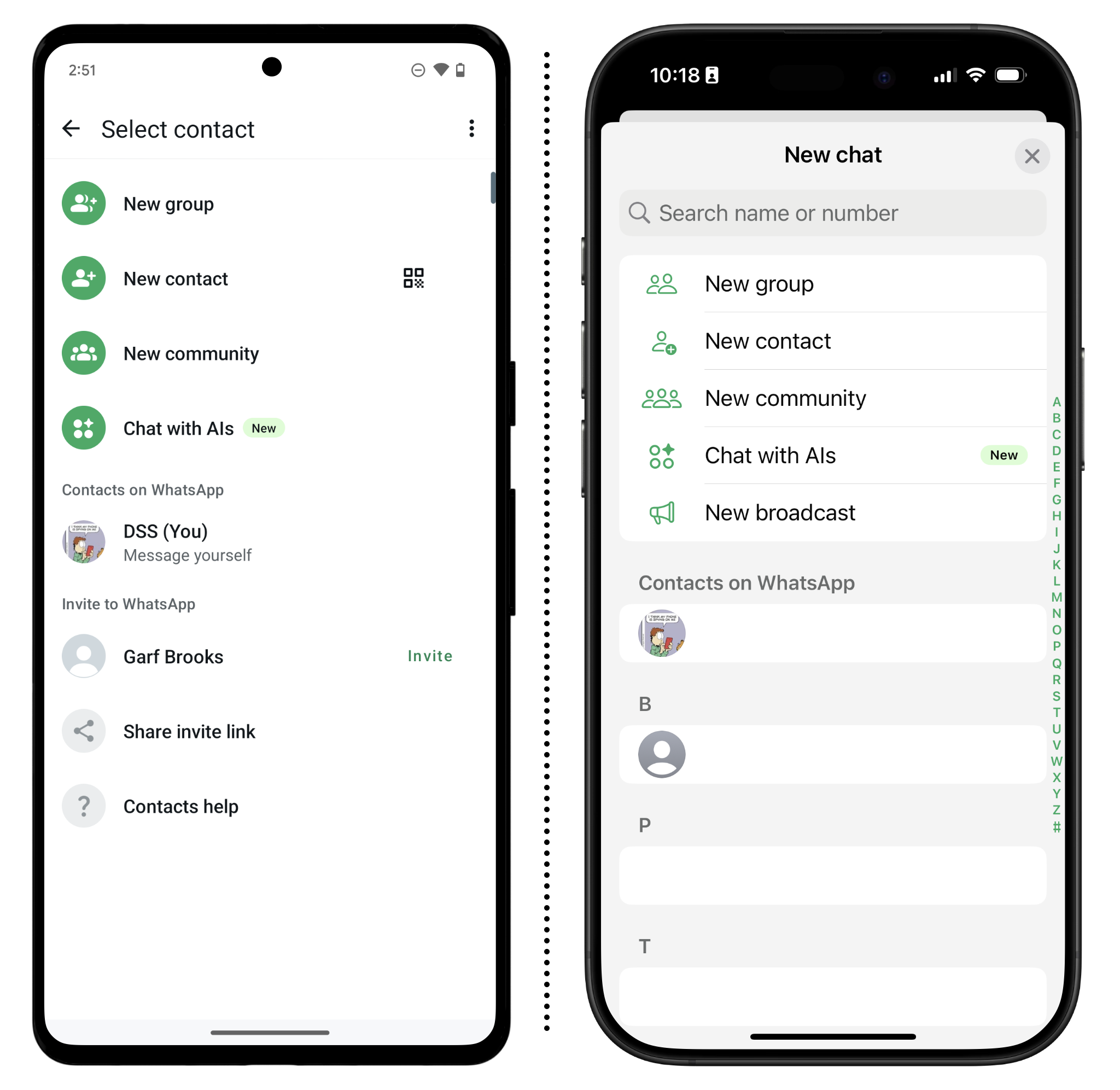
También puedes ajustar algunas opciones de los grupos que crees, como si otros pueden o no añadir nuevos participantes, o si los administradores tienen que aprobarlos:
- En Android: Abre un chat de grupo, toca el nombre y, a continuación, desplázate hacia abajo y toca "Permisos de grupo."
- En iPhone: Abre un chat de grupo, pulsa el nombre y, a continuación, desplázate hacia abajo y pulsa "Permisos de grupo."
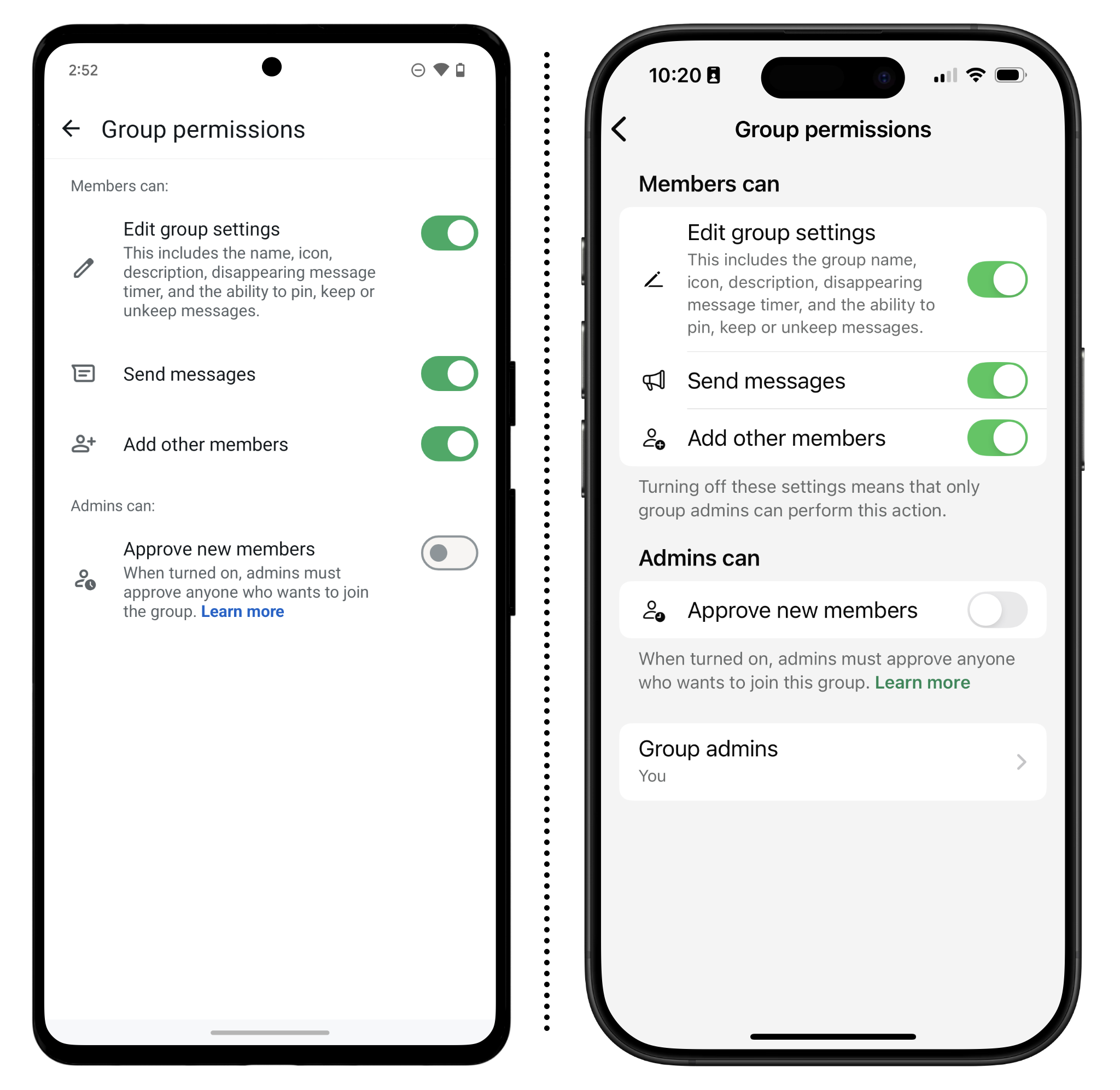
Por defecto, cualquiera puede añadirte a un chat de grupo, igual que con un mensaje SMS normal. Pero puedes cambiar esta configuración:
- En Android: Toca el icono de los tres puntos (⋮) > Configuración > Privacidad > Grupos.
- En iPhone: Toca Configuración > Privacidad > Grupos.
Aquí encontrarás tres opciones para elegir:
- Todos: Con este ajuste, todo el mundo, incluidas las personas que no están en tu agenda, puede añadirte a grupos sin tu aprobación.
- Mis contactos: Sólo las personas de tu lista de contactos pueden añadirte a grupos sin tu aprobación. Si alguien no está en tu lista de contactos, recibirá una ventana emergente pidiéndole que te invite.
- Excepto Mis contactos: Con esta opción, puedes seleccionar contactos específicos de la agenda de tu teléfono que no pueden añadirte a grupos sin tu aprobación.
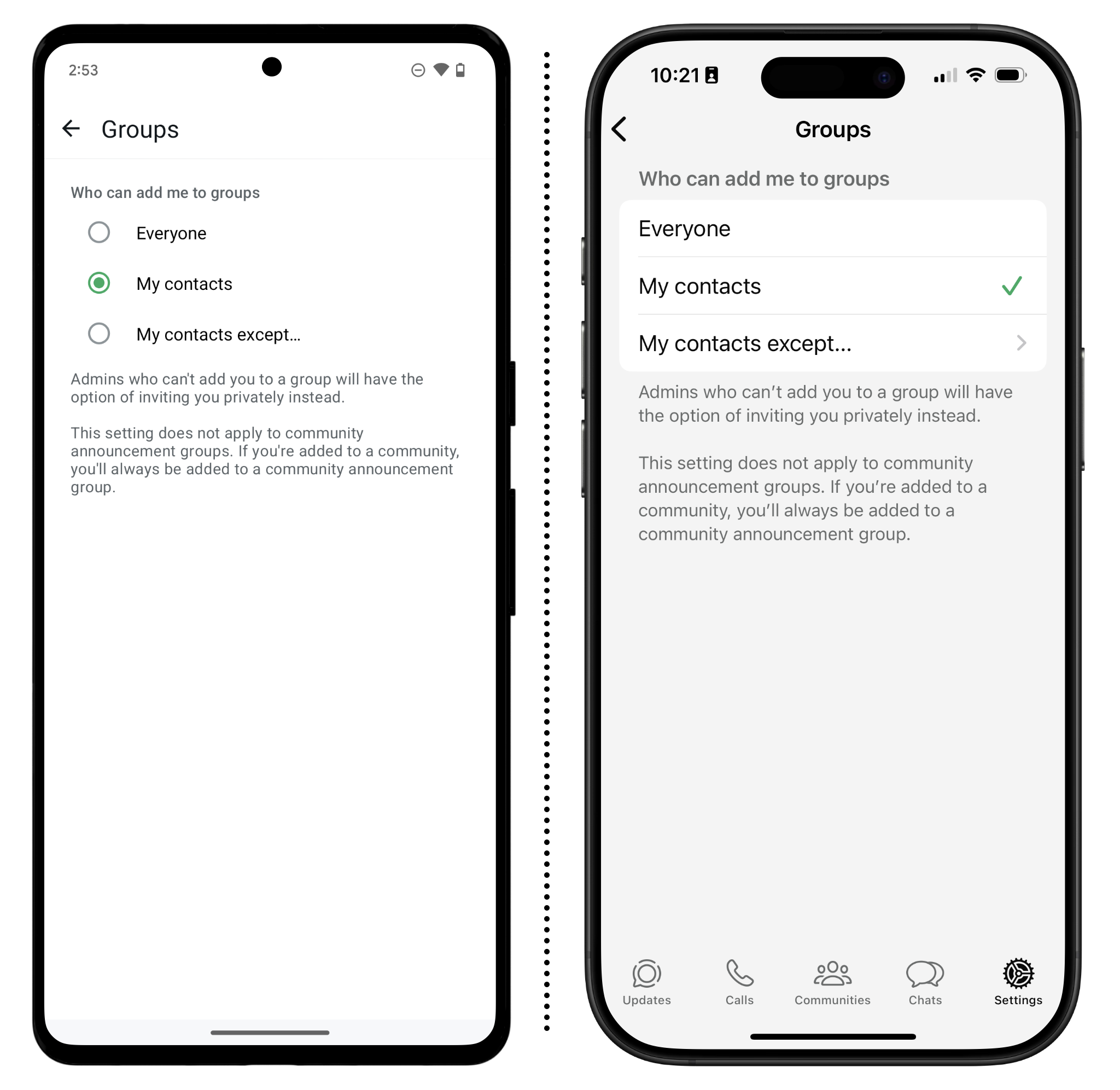
Si estás en un chat de grupo o comunidad y quieres salir, puedes seleccionar el chat de grupo o la comunidad que quieras abandonar y, a continuación, pulsa el nombre del grupo en la parte superior de la pantalla. En la siguiente pantalla, desplázate hasta la parte inferior y pulsa "Salir del grupo".
Ajustes de seguridad adicionales
Seguridad de la cuenta
Hay algunos ajustes básicos de seguridad que todo el mundo debería cambiar en WhatsApp, independientemente de tus preocupaciones sobre seguridad.
Activar el cifrado de extremo a extremo en las copias de seguridad
Por qué
WhatsApp ofrece la opción de hacer copias de seguridad de tus chats. De esta forma, puedes restaurar tus chats si los pierdes o cambias de teléfono. Estas copias de seguridad son opcionales y no están activadas por defecto. WhatsApp te permite almacenar estas copias de seguridad con o sin cifrado. Si decides habilitar las copias de seguridad, para una mayor protección, habilita la copia de seguridad cifrada de extremo a extremo opcional. Con esta opción activada, WhatsApp, Google (o Apple), no podrán acceder a la información de la copia de seguridad.
Qué debes hacer
- En Android: Toca el icono de tres puntos (⋮) > Ajustes > Chats > Copia de seguridad de chats para acceder a la pantalla de copia de seguridad. A continuación, toca "Copia de seguridad cifrada de extremo a extremo" y activa la función.
- En iPhone: Ve a Ajustes > Chats > Copia de seguridad del chat para llegar a la pantalla de copia de seguridad. A continuación, pulsa "Copia de seguridad cifrada de extremo a extremo" y activa la función.
Cuando actives la copia de seguridad cifrada de extremo a extremo, se te preguntará si deseas establecer una contraseña o utilizar una clave de cifrado. Asegúrate de guardar esta clave o contraseña en algún lugar seguro, como un gestor de contraseñas, ya que WhatsApp no podrá ayudarte a recuperar tu copia de seguridad si la pierdes.
Recuerda que cualquier persona con la que chatees también puede hacer una copia de seguridad de sus chats, incluso de una forma que no utilice el cifrado de extremo a extremo. Si esto te preocupa, asegúrate de ayudar a tus contactos a cambiar también su configuración.
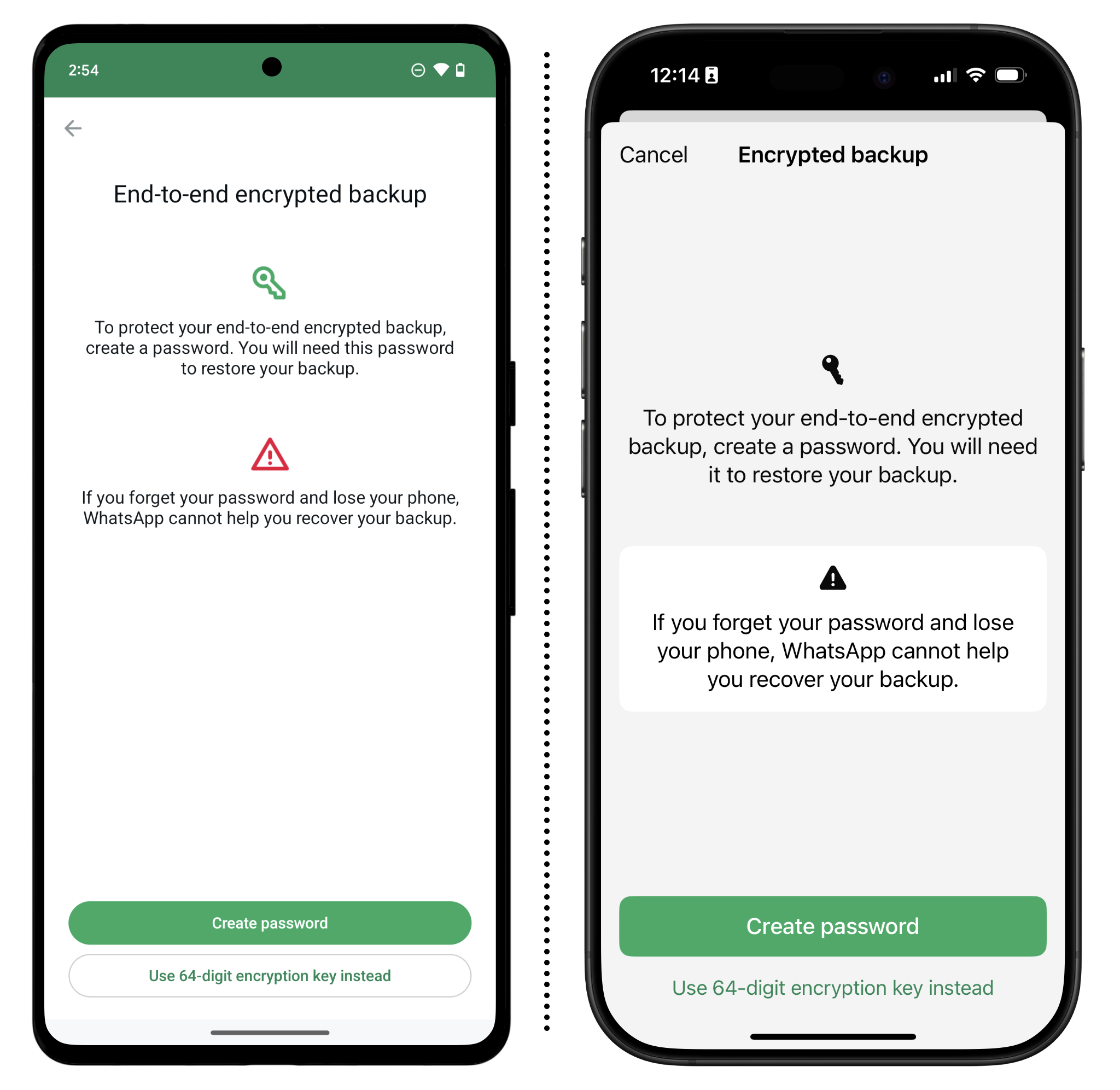
Activa la verificación en dos pasos
Por qué
Para mayor seguridad, deberías considerar activar la verificación en dos pasos. Esto hace que puedas establecer un PIN que se requiere antes de que puedas iniciar sesión en WhatsApp en otro teléfono.
Qué debes hacer
- En Android: Toca el icono de tres puntos (⋮) > Ajustes > Cuenta > Verificación en dos pasos. Una vez allí, toca el botón "ActivarEnable " para activarla.
- En iPhone: Toca Ajustes > Cuenta > Verificación en dos pasos. Una vez allí, toca el botón "Activar" para activarla.
Una vez que actives select the "E" la opción de verificación de dos factores , se te pedirá que crees un PIN de seis dígitos y que luego confirmes ese número. También puedes añadir una cuenta de correo electrónico opcional que te ayudará a restablecer el PIN si lo olvidas.
La aplicación te pedirá periódicamente que introduzcas este PIN cuando abras WhatsApp para ayudarte a recordarlo.
WhatsApp también admite passkeys , otra forma de proteger tu cuenta. Si estás interesado en iniciar sesión con una clave de acceso, sigue las instrucciones de WhatsApp .

Bloquear la aplicación o chats individuales
Por qué
Si utilizas datos biométricos (como Face ID o Touch ID) o un PIN para bloquear tu teléfono, también puedes bloquear toda la aplicación WhatsApp o chats individuales. Esto significa que después de desbloquear tu teléfono, tendrás que autenticarte de nuevo para abrir la aplicación o acceder a los chats.
Qué hacer
Para bloquear toda la app
- En Android: Toca el icono de tres puntos (⋮)> Ajustes > Privacidad> Bloqueo de la aplicación, y activa la opción "Desbloquear con biométrica".En el iPhone: pulsa Ajustes > Privacidad > App Bloquear y activa la opción "Requerir Face ID (o Touch ID)".
Una vez activada, puedes seleccionar un periodo de tiempo antes de que la aplicación vuelva a bloquearse automáticamente.
Si no necesitas bloquear toda la aplicación pero quieres proteger chats específicos:
- En Android: Toca el nombre (o número de teléfono) del chat, luego desplázate hacia abajo hasta "Bloqueo de chat" y toca el conmutador para activarlo. "
- En iPhone: Pulsa el nombre (o número de teléfono) del chat, luego desplázate hacia abajo hasta "Bloquear chat ," y pulsa el conmutador para activarlo.
Con la función de bloqueo de chat activada, el hilo del chat se moverá a una carpeta separada de "Chats bloqueados" a la que tendrás que desplazarte hacia abajo desde la pantalla de inicio de WhatsApp para llegar a ella. Las notificaciones no incluirán el contenido de los mensajes de estos chats, independientemente de cuáles sean tus otros ajustes de previsualización de mensajes.
También puedes proteger aún más los chats bloqueados con un "Código secreto", que oculta un chat específico para que sólo se pueda descubrir buscando el código secreto en la barra de búsqueda. Consulta la documentación de WhatsApp para saber cómo utilizarlo.
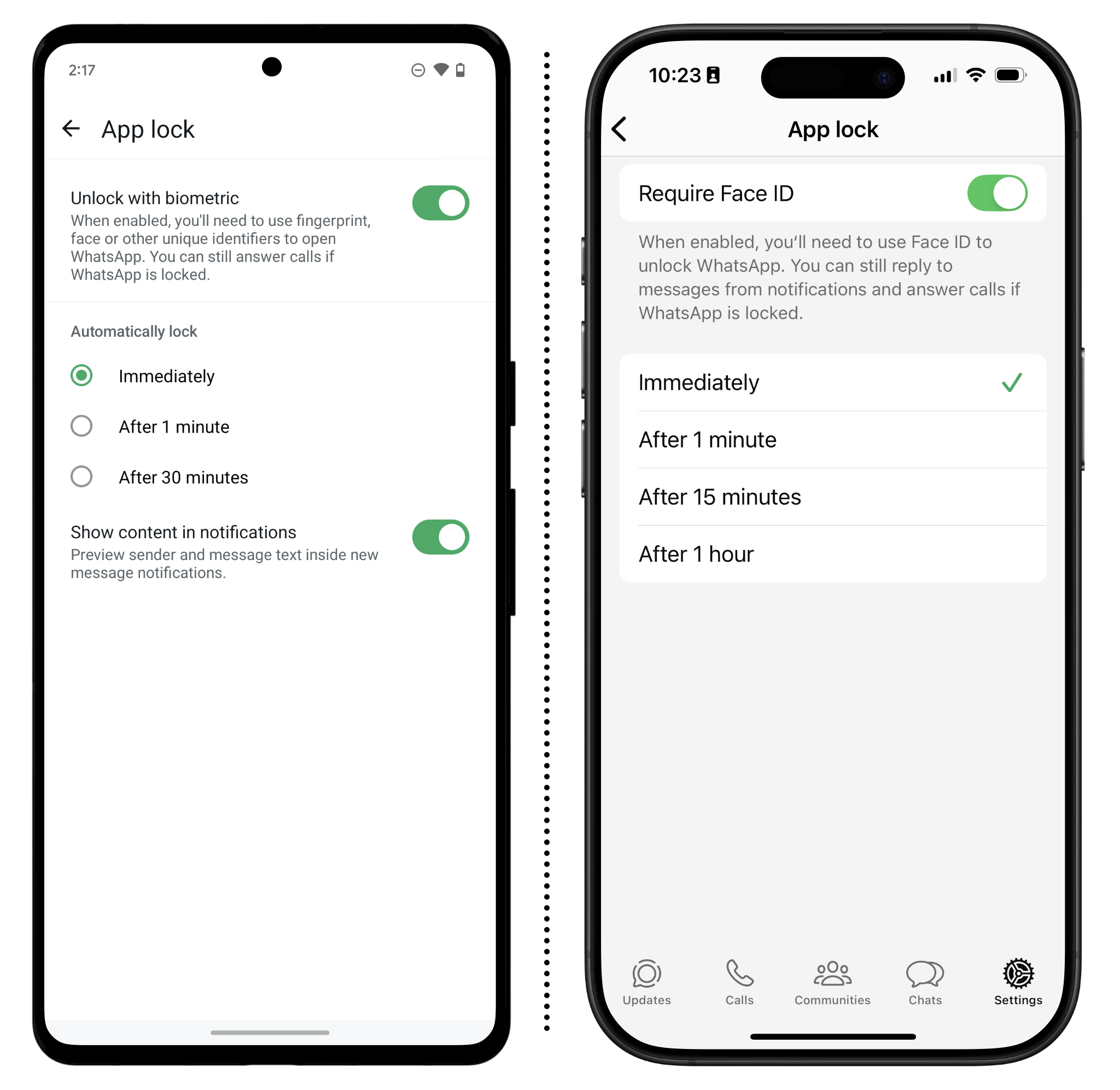
Revisar la configuración de privacidad
Por qué
Al igual que una red social, WhatsApp tiene una serie de ajustes de privacidad específicos, como si las personas pueden ver o no cuándo estás conectado, o si reciben "recibos de lectura", que tal vez quieras considerar cambiar.
Qué hacer
- En Android: Pulsa el icono de tres puntos (⋮)> Ajustes > Privacidad, y repasa cada opción para asegurarte de que no compartes más de lo que pretendes.
- En el iPhone: Pulsa Configuración > Privacidad, y revisa cada opción para asegurarte de que no compartes más de lo que pretendes.
También puedes ejecutar la "Comprobación de privacidad" en esta página para obtener una orientación más detallada.![]()
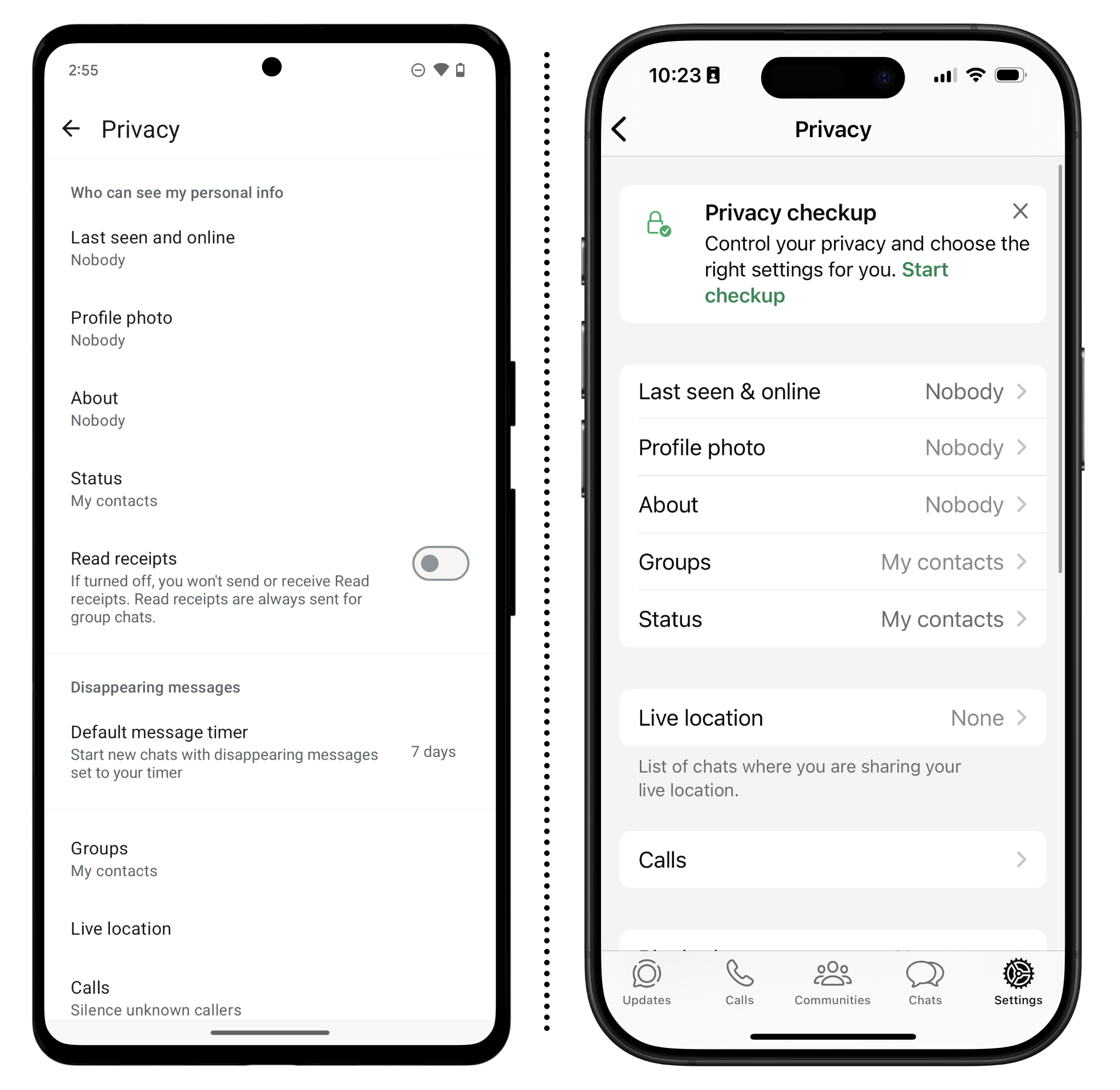
Ajustes de seguridad adicionales para situaciones más delicadas
Aparte de los ajustes anteriores, WhatsApp incluye una serie de ajustes de seguridad más específicos que no todo el mundo necesitará tener en cuenta, pero que son útiles si tu plan de seguridad lo requiere.
Cambiar la duración de los mensajes que desaparecen
Por qué
WhatsApp ofrece varias opciones para los mensajes que desaparecen, en los que los mensajes se borran tras un tiempo determinado. La duración de los mensajes que desaparecen se aplicará tanto a ti como al destinatario, pero ten en cuenta que antes de que los mensajes desaparezcan, el destinatario podría hacer una captura de pantalla de los mismos. Si optas por activar esta función, puedes elegir entre 24 horas, siete días o 90 días. Si te preocupa que alguien acceda físicamente a tu teléfono para ver los mensajes de tu dispositivo, como las fuerzas de seguridad o tus familiares, es una función que merece la pena activar. Pero recuerda que las personas con las que chateas pueden registrar o hacer capturas de pantalla de vuestra conversación, aunque hayas activado la desaparición de mensajes.
Qué hacer
Para configurar esto para cada chat
- En Android: Toca el icono de los tres puntos (⋮)> Configuración > Privacidad > Temporizador de mensajes predeterminado, y elige la duración que desees como predeterminada.
- En el iPhone: Pulsa Ajustes > Privacidad > Temporizador de mensajes predeterminado, y elige la duración que desees como predeterminada.
También puedes configurarlo a nivel individual para cada conversación. Abre un hilo de conversación, luego pulsa el nombre (o número de teléfono), desplázate hacia abajo hasta "Desaparecer mensajes" y selecciona el tiempo de duración que desees para ese chat específico.
Ten en cuenta que cuando respondes a un mensaje que luego se borra, es posible que el texto citado permanezca durante un breve espacio de tiempo.
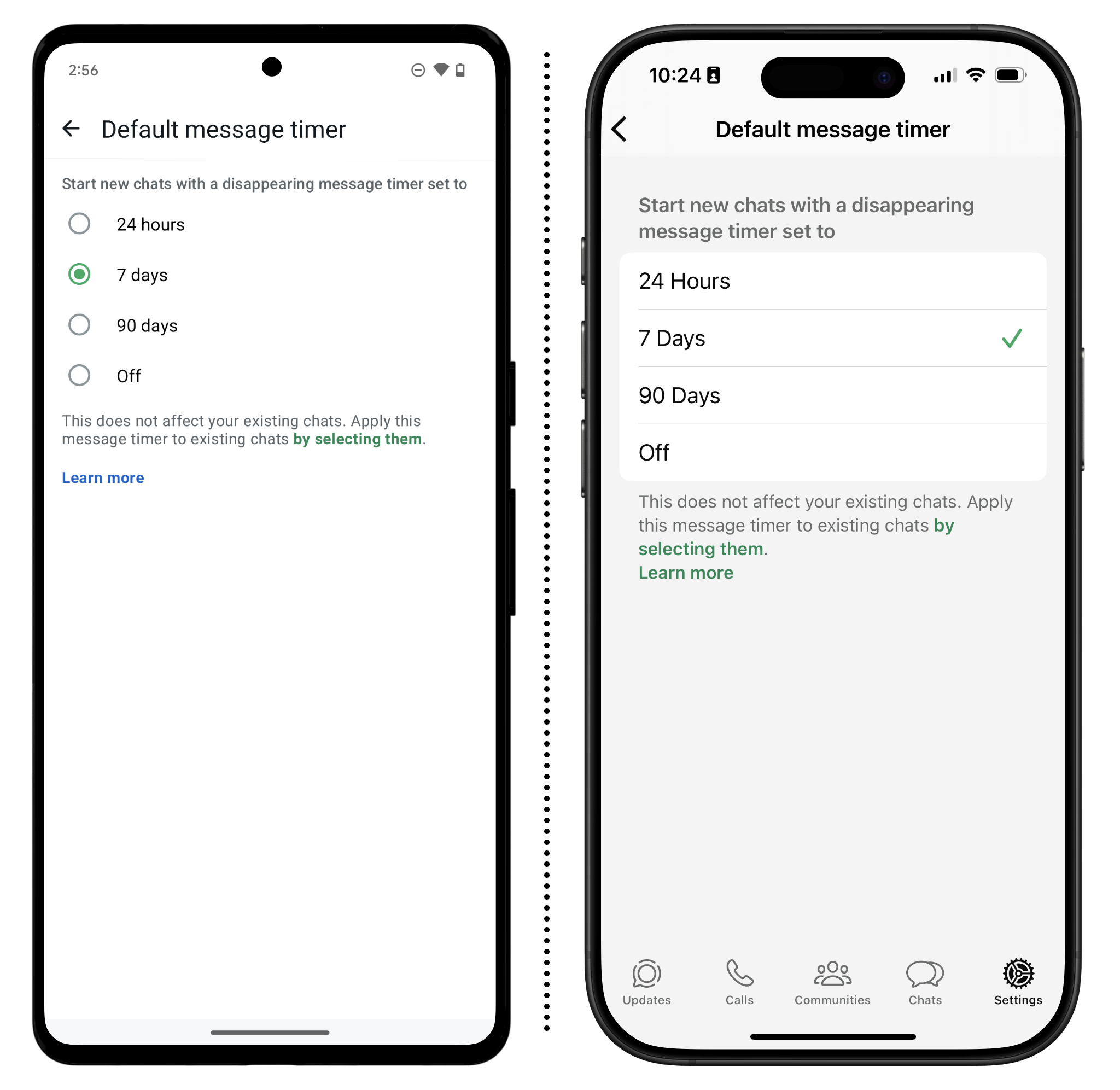
Utiliza el modo "Ver una vez" para las fotos sensibles
Por qué
Cuando envías fotos en un chat, puedes configurar opcionalmente esa foto para que sólo pueda verse una vez. El destinatario sólo podrá abrir la foto una vez, y después se borrará. WhatsApp también bloqueará las capturas de pantalla, aunque ten en cuenta que alguien aún podría hacer una foto de su teléfono con otro dispositivo.
Qué hacer
Para utilizar "ver una vez", abre un chat y:
- En Android: Toca el icono del clip > Galería y, a continuación, selecciona la foto que quieras enviar. En la siguiente pantalla, toca el botón "1" para activar "ver una vez" y, a continuación, toca el icono de la flecha para enviar el mensaje.
- En el iPhone: Toca el símbolo "+" > Fototeca, y selecciona la foto que quieras enviar. En la siguiente pantalla, pulsa el botón "1" para activar "ver una vez" y, a continuación, pulsa el icono de la flecha para enviar el mensaje.
Recibirás un recibo en el chat diciendo que se ha abierto la imagen.
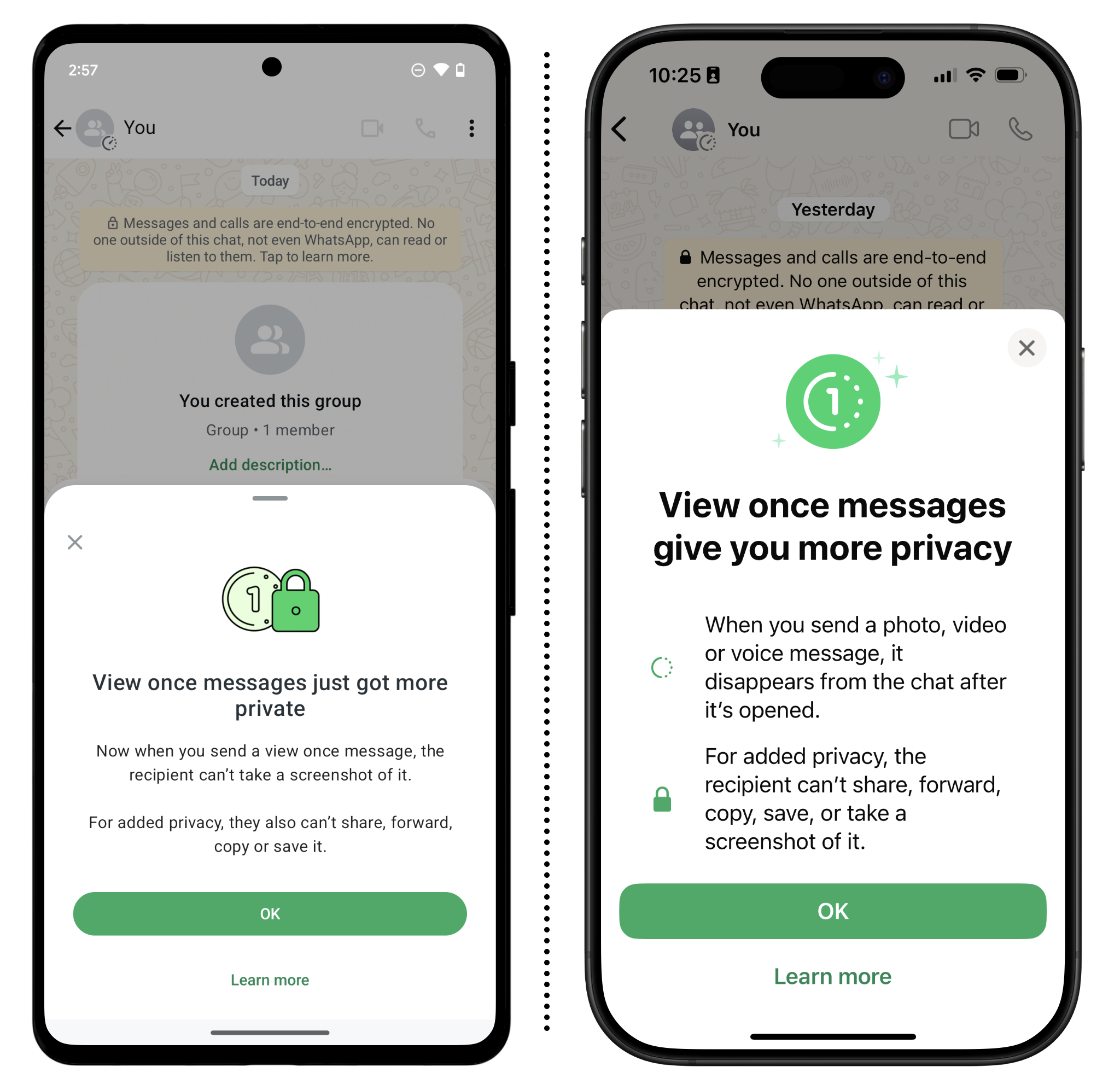
Mostrar notificaciones de seguridad
Por qué
Si por alguna razón cambia la clave de encriptación de un contacto, puede que quieras que se te notifique este cambio. Normalmente, un cambio de clave no es motivo de alarma: suele ocurrir como resultado de la reinstalación de una aplicación o del cambio de teléfono. Pero existe la posibilidad de que un cambio de clave sea causado por un tercero malintencionado que realice un ataque man-in-the-middle. Por esta razón, es una buena práctica verificar (como se ha descrito anteriormente) una vez más cuando cambie la clave de tu contacto. Por defecto, WhatsApp no muestra cuando cambian las claves de un contacto.
Qué hacer
- En Android: Toca el icono de tres puntos (⋮)> Ajustes > Cuenta > Notificaciones de seguridad, y activa "Mostrar notificaciones de seguridad en este dispositivo".
- En iPhone: Toca Configuración > Cuenta > Notificaciones de seguridad, y activa "Mostrar notificaciones de seguridad en este teléfono."
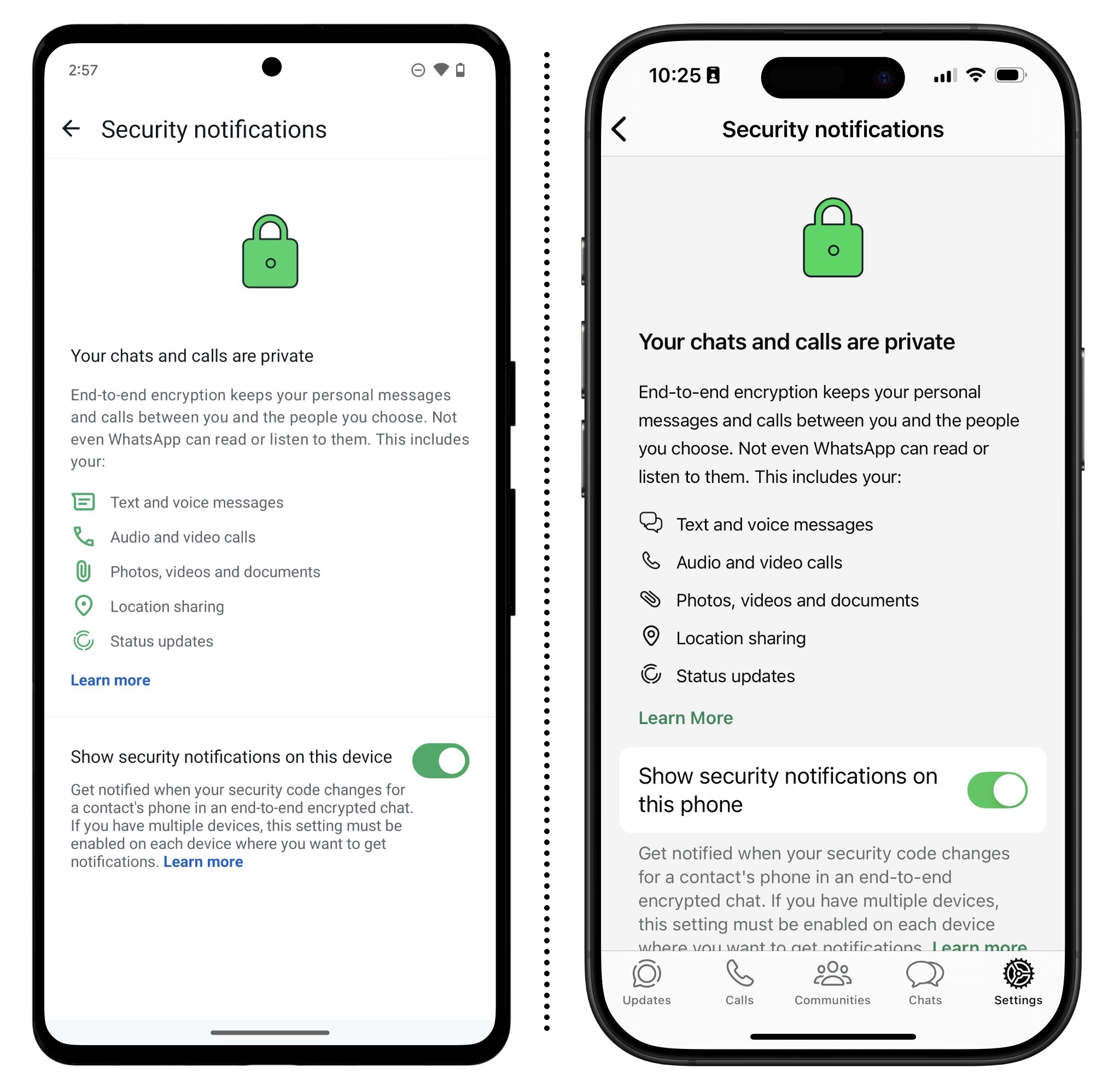
Conectarse a través de un servidor proxy
Por qué
Si no puedes acceder a WhatsApp porque el servicio está bloqueado en tu región, puedes probar a utilizar un servidor proxy. Cuando te conectas a un servidor proxy, te conectas a un servidor configurado por voluntarios, no por WhatsApp, lo que en algunas situaciones puede ayudarte a utilizar WhatsApp en lugares donde está bloqueado. Acceder a WhatsApp a través de un servidor proxy es sencillo, pero para encontrar uno fiable tendrás que buscar en Internet. Cuando necesites un proxy, lo mejor suele ser buscarlo en las redes sociales.
Qué debes hacer
Para utilizar un servidor proxy
- En Android: Toca el icono de los tres puntos (⋮)> Ajustes > Almacenamiento y datos > Proxy > Configurar proxy, e introduce la dirección proxy de un proveedor de confianza. En la mayoría de los casos, no tendrás que preocuparte de configurar los puertos.
- En el iPhone: Pulsa Ajustes > Almacenamiento y Datos > Proxy > Configurar Proxy, e introduce la dirección proxy de un proveedor de confianza. En la mayoría de los casos, no tendrás que preocuparte de configurar los puertos.
Si la conexión con el proxy se realiza correctamente, verás un mensaje de estado indicándote que funciona. Al utilizar un servidor proxy, tus mensajes siguen estando encriptados de extremo a extremo, aunque el proveedor del proxy puede ver tu dirección IP .
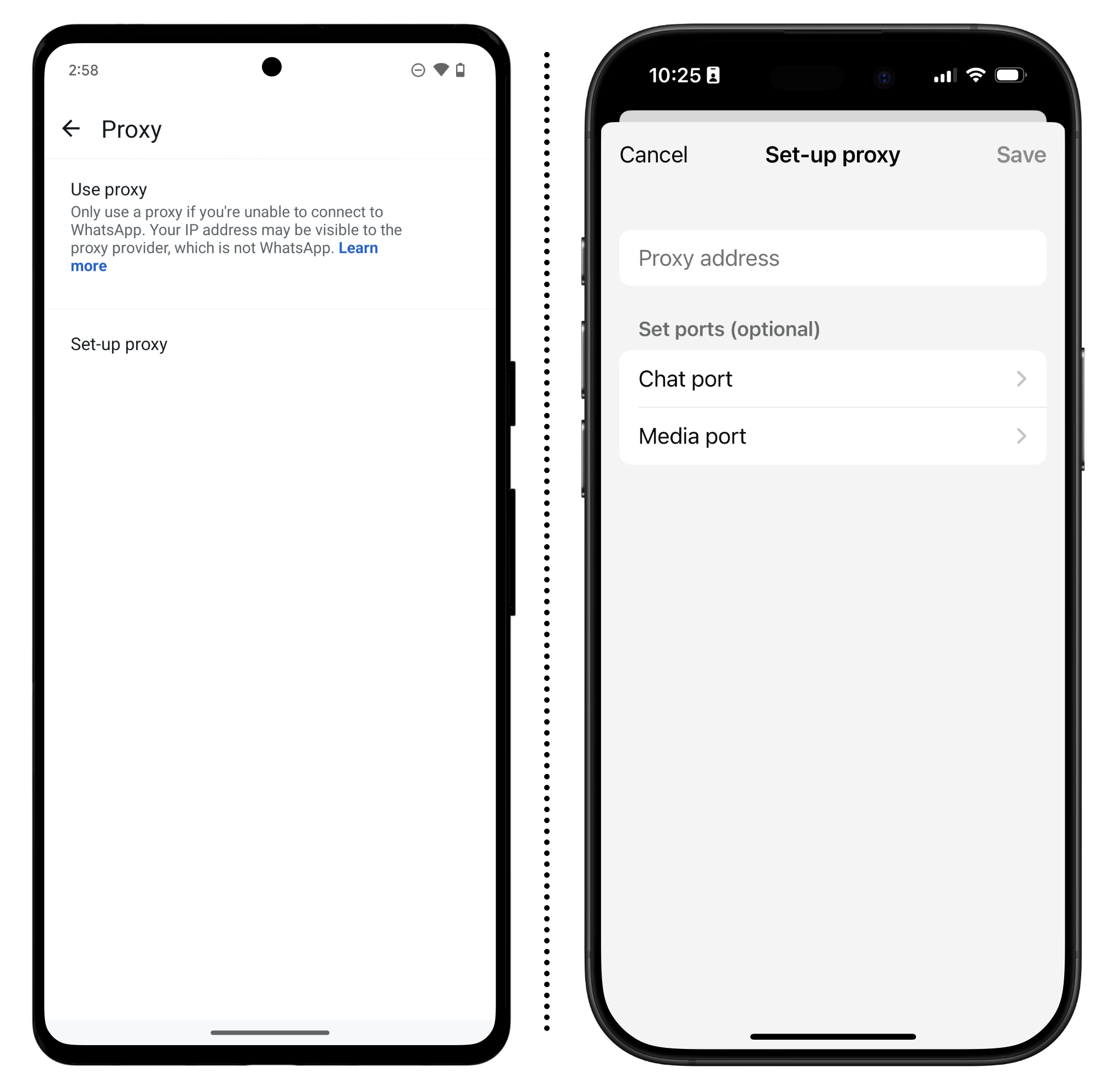
Ocultar tu dirección IP a quien te llama
Por qué
Si te encuentras en una circunstancia en la que estás llamando a alguien en quien no confías (o te están llamando a ti), considera la posibilidad de cambiar la forma en que WhatsApp enruta tu llamada. Por defecto, WhatsApp alterna entre enrutar las llamadas a través de un servidor y las llamadas entre pares, lo que puede filtrar tu dirección IP a la otra persona que llama. Puedes forzar que una llamada se dirija a través del servidor para proteger tu dirección IP, pero a costa de la claridad de la llamada.
Qué hacer
- En Android: Toca el icono de tres puntos (⋮) > Ajustes > Privacidad > Avanzado, y activa "Proteger dirección IP en llamadas".
- En iPhone: Toca Ajustes > Privacidad > Avanzado, y activa "Proteger dirección IP en llamadas".

Desactivar la vista previa de enlaces
Por qué
Las vistas previas de enlaces pueden revelar información sensible sobre ti al sitio web al que enlazas, como la versión exacta de WhatsApp que utilizas, también pueden utilizarse para enumerar a los amigos con los que te comunicas por WhatsApp si hay un aspecto único en la url, como un token de seguimiento en la URL como, https://instagram.com/aslk_234?sid=a1b2c3d5
Qué hacer
- En Android: Toca el icono de tres puntos (⋮)> Ajustes > Privacidad > Avanzado, y activa "Desactivar vista previa de enlaces".
- En el iPhone: Toca Ajustes > Privacidad > Avanzado, y activa "Desactivar previsualización de enlaces".
